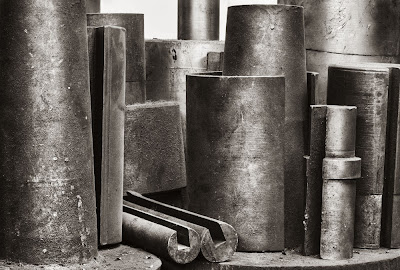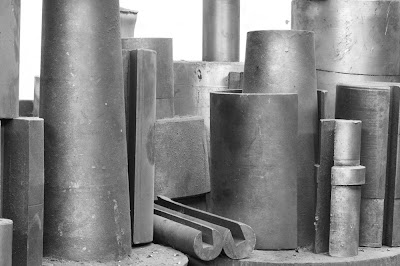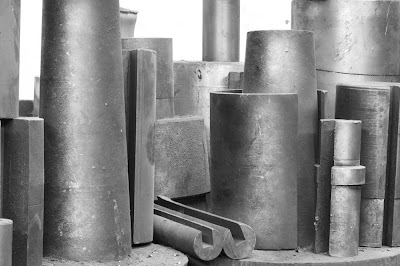
I have been asked to explain how I managed to make the metal cylinders image look so round when the original image was so flat. This was easy but not automatic, you need to apply effects to certain parts of an image only - as it happens, that's quite easy with the image above since the parts to be rounded are quite large and painting isn't critical.
The first thing was to convert the image to black and white. In the past I'd have done this with a Russell Brown routine but now use the very nice Photoshop CS3 black and white adjustment layer, in this case with a green filter - I liked the effect.

You will note that the lighting is all too even for an interesting picture and the shapes look really flat, two dimensional, dull, boring, did I say flat.
Making something look rounded is a matter of deciding where the light is going to come from. Since it didn't have any direction before, I get to choose where and all the parts that reflect from that direction need to be lightened, everything reflecting 90 degrees from that needs to be darkened. In this case I chose from behind me, though I could have chosen left or right of me.
To create the effect I need to create a lighten curve and black mask it then paint into the appropriate areas. Next was a darken curve and after that a couple more doing the same thing but at different points of brightness. I then used an increase contrast curve. You see the sequence below.



As you can see we have made considerable progress into rounding the shapes. The difference between the last image and the final one at the top is just more of same, a series of curves adjustment layers.
The same thing can be done in nature too - I have added depth to erosions in the badlands through this technique. With a bit of practice it's possible to take an evenly gray circle and turn it into a very convincing sphere. In that case you could use gradients, but this more applicable in the real world manipulation of images.

In the last image there was an overall darkening then some final work with the dodge brush set to highights - 5 - 10 % effect.
If it's not a perfect match for the final image above, that's because all this was done in about 15 minutes, including writing the blog, and the image hasn't been 'toned' yet.



6 comments:
George, this is truly remarkable. What a great demonstration of "painting". Even my wife said "Wow". Thanks for showing this!
Love the look. Thanks for the walk-thru. Would anyone know if it is possible to accomplish the (nearly)same thing via LightRoom?
Perhaps Lightroom users can comment but my understanding from the luminous landscape tutorials is that lightroom has only one local control and that's cloning for dust removal, all other effects are applied globally and this kind of work has to be applied locally.
It's time to step up and admit being a silent visitor--one who slips in quietly, trips the counter, then disappears--one of those repeat offenders. Thank you for the time and effort that goes into your posts and congratulations on the success of your site.
George: you are absolutely right. Lightroom currently can do only global changes (though quite a few of them, and extremely nicely). However, for "traditional" darkroom-like work that I, you and other fine-art photographers need to do, something else (i.e., PhotoShop or equivalent) is needed. I'm still learning Lightzone (though workhorse remains Photoshop, essentially due to familiarity); it *is* a very viable alternative to Photoshop and has loads of local controls.
BTW: Congrats on the book! If the content is *no more than* your blog posts it is sure to be a runaway success, and will be of value to a tremendous number of people (myself included). If it is even more (as it is surely to be), all I can say is "Wow!" finally a photographer's book for photographers; where's the waiting list, sign me up!
An artist, George, does not manipulate. An artist enhances. The workd manipulate, particularly since it starts with a gender devisive prefix, is politically incorrect. :)
Post a Comment